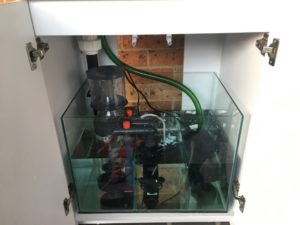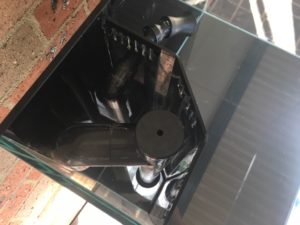 Growing up with freshwater aquariums and with a passion for the ocean and scuba diving I had been considering starting a marine tank since around 2012 (I think). I hadn’t owned any aquarium for a long time now (10 years or so) and never even progressed to a tropical tank so mostly I only had a few easy to keep freshwater species. But the lure of having my own piece of the reef and maintaining a marine tank kept calling me.
Growing up with freshwater aquariums and with a passion for the ocean and scuba diving I had been considering starting a marine tank since around 2012 (I think). I hadn’t owned any aquarium for a long time now (10 years or so) and never even progressed to a tropical tank so mostly I only had a few easy to keep freshwater species. But the lure of having my own piece of the reef and maintaining a marine tank kept calling me.
I read into it a bit and got my head around the basics but still it always seemed a bit daunting about where to start with so much options available it was hard to know where was the right place for me to start. Anyway I got to the point where I had done a decent amount of reading and I just wanted to get my hands wet – there gets a point where you just need to work things out as you go along a bit as well.
 I had read a few books leading up to taking the plunge but ultimately settled on The Conscientious Marine Aquarist by Robert M. Fenner as a foundational reference. Supplemented heavily by online searches and forums such as MASA, Reef2Reef, Nano-Reef and local (Australian based) Facebook based community groups.
I had read a few books leading up to taking the plunge but ultimately settled on The Conscientious Marine Aquarist by Robert M. Fenner as a foundational reference. Supplemented heavily by online searches and forums such as MASA, Reef2Reef, Nano-Reef and local (Australian based) Facebook based community groups.
Everything I read said “bigger is better” with respect to being a beginner in this hobby because a larger volume of water makes it easier to keep water parameters stable and negative changes might happen a bit more slowly giving a beginner greater chance in avoiding problems. However bigger also means increased setup costs (although better stability could mean lower costs in the longer run, maybe). There was agreed upon size but generally speaking it was recommended 150L+, which was still a decent sized tank. After much indecisiveness (wanting to balance easing myself into the hobby, large volume of water for stability and startup costs) I ended up settling on an AquaOne MiniReef 120. While not quite the 150L recommended for beginners, it was probably around that volume taking into consideration the sump, it was a reasonable starting price point and as it comes standard is a good starting point.
 After some hunting I found a secondhand MiniReef 120L which was only a few months old and looked in good condition for a good price. It included the stock bits and pieces (protein skimmer, lights, cabinet and sump etc). I managed to get it home in one piece but being a secondhand tank and new to the hobby I didn’t want to take any chances so step one – leak test! I set it up outside which was great because I didn’t have to be precious about splashing water about everywhere. Got everything setup and then powered it up to run it in for around 24 hours and check for any issues. 24 hours later it was still holding steady! Next step is to set it up inside.
After some hunting I found a secondhand MiniReef 120L which was only a few months old and looked in good condition for a good price. It included the stock bits and pieces (protein skimmer, lights, cabinet and sump etc). I managed to get it home in one piece but being a secondhand tank and new to the hobby I didn’t want to take any chances so step one – leak test! I set it up outside which was great because I didn’t have to be precious about splashing water about everywhere. Got everything setup and then powered it up to run it in for around 24 hours and check for any issues. 24 hours later it was still holding steady! Next step is to set it up inside.